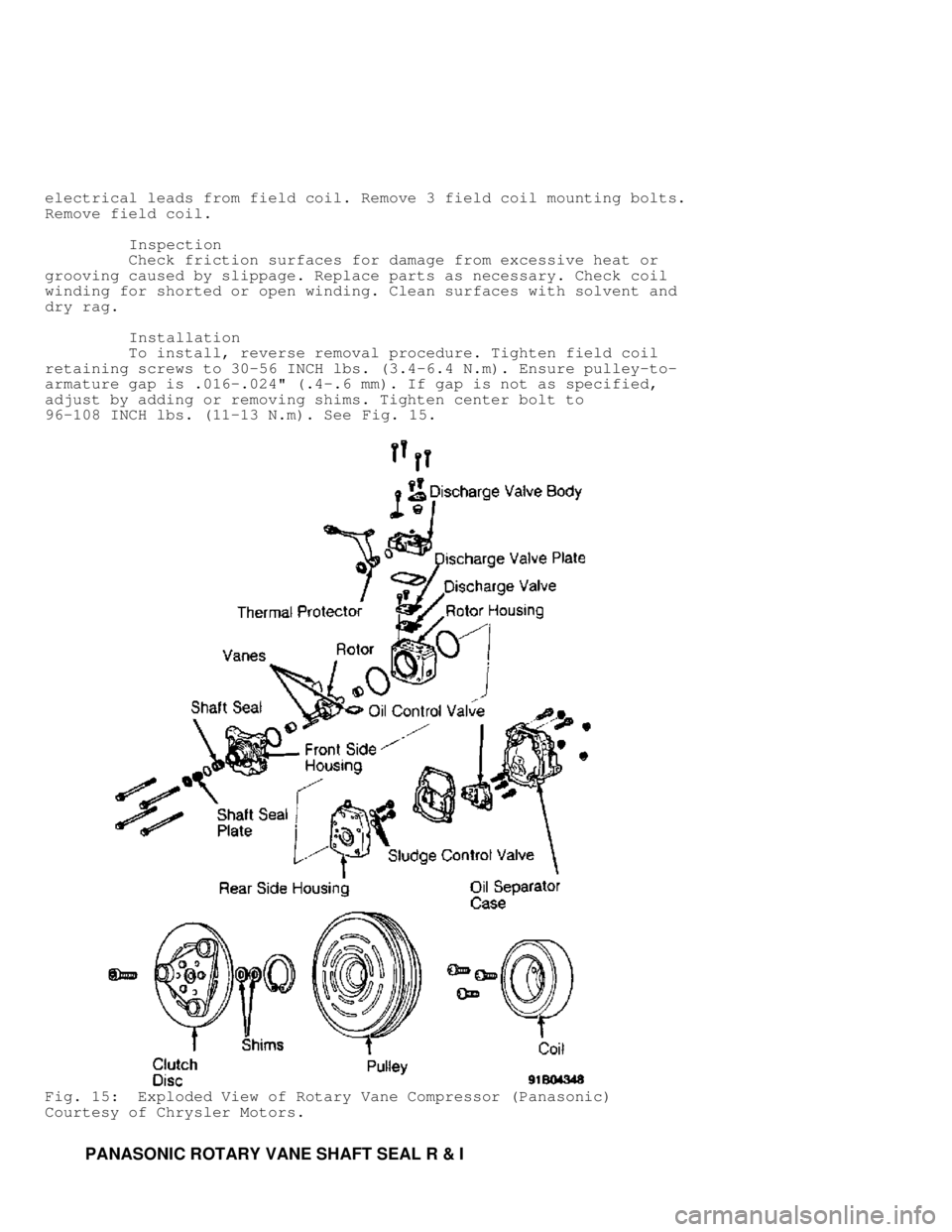1991 MITSUBISHI MONTERO adding oil
[x] Cancel search: adding oilPage 26 of 1333

separate oil pan from cylinder block. Remove pan from vehicle.
Removal (3000GT)
1) Raise and support vehicle. Remove engine undercovers.
Drain engine oil. Disconnect O2 sensor connector. Remove front exhaust
pipe from manifolds. On All-Wheel Drive (AWD) models, drain transfer
assembly. Remove front air dam. Remove AWD drive shaft and transfer
assembly.
2) On turbocharged models, remove oil return lines from oil
pan. On all models, remove starter. Remove crossmember and transaxle
stays. Remove bellhousing cover. Remove oil pan bolts. Using Seal
Cutter (MD998727), separate oil pan from cylinder block. Remove pan
from vehicle.
Inspection (All Models)
Clean sealant from oil pan mating surface on engine block and
oil pan. Check oil pan for cracks and damage. Check sealing surface
for damage and deformation. Inspect oil pick-up screen for damage.
Installation (All Models)
1) To install, reverse removal procedure. Apply sealant to
oil pan flange in a continuous .16" (4 mm) diameter bead. See Fig. 22.
Install oil pan within 15 minutes of applying sealant.
2) Tighten bolts to specification in proper sequence. See
appropriate TORQUE SPECIFICATIONS table at end of article. Wait at
least 30 minutes before adding oil and starting engine. On AWD models,
refill transfer assembly with GL-4 hypoid gear oil. On all models,
complete installation by reversing removal procedure.
Fig. 22: Sealant Application & Oil Pan Bolt Tightening Sequence
Courtesy of Mitsubishi Motor Sales of America, Inc.
OVERHAUL
Page 44 of 1333

compressor. Evacuate and recharge system. Perform leak test.
HARRISON 4-CYL DRAIN & REFILL
NOTE: The Harrison compressor DOES NOT have an oil sump. It's
crucial that the compressor remains well oiled. It takes
very little time to destroy this compressor if it runs dry.
The Harrison 4-cyl compressor is charged (new) with 6 ounces
of refrigerant oil. Because compressor does not have an oil sump, it
should not have to be removed for oil measurement (it retains very
little oil). Note the following situations for checking and adding oil
to this compressor.
NO OIL LEAK; REPLACING COMPONENTS
If only the compressor is to be replaced, remove, drain oil,
measure and reinstall an equal amount of new oil. If evaporator is
being replaced, add 3 ounces of new oil. If condenser is being
replaced, add one ounce.
LOSS OF REFRIGERANT OVER EXTENDED PERIOD
When a loss of refrigerant has occurred over an extended
period of time and a component is being replaced to correct the leak,
add an appropriate amount of refrigerant oil to the component.
SIGNS OF EXCESSIVE OIL LEAKAGE
If system has lost excessive oil, remove accumulator. Drain
and measure oil. If more than 3 ounces is measured, replace the same
amount of new oil as was drained. If less than 3 ounces is measured,
add 3 ounces of new oil. Add and additional 2 ounces of new oil to
compensate for that lost by replacing the accumulator (held in
desiccant).
NOTE: If the exact oil charge is in doubt, drain and flush system.
Add a new 6-ounce charge of refrigerant oil to the system.
HARRISON V5 5-CYLINDER DRAIN & REFILL
1) If system is operable, run for several minutes to
stabilize system before performing repairs. Turn off engine. Discharge
system and remove compressor. See SERVICING PRECAUTIONS at the
beginning of this article. Remove drain plug. Drain and measure oil.
2) If more than one ounce is drained, add same amount. If
less than one ounce is drained, add 2 ounces of new refrigerant oil to
compressor.
3) If A/C components are replaced, add refrigerant oil to
system. Add one ounce if condenser is replaced. Add 3.5 ounces if
accumulator is replaced.
4) When replacing a component which has caused a large
refrigerant leak, add 3 ounces of new oil plus the required amount for
the part being replaced. Add oil directly to part being replaced if
possible. If oil can not be easily added to part, add oil to
accumulator.
NOTE: If oil drained contains metal chips or other debris, replace
receiver-drier. Flush out system before evacuating and
recharging.
Page 65 of 1333

Removal
1) Remove A/C compressor. Remove pressure plate shaft bolt
using socket wrench and Clutch Stopper (07112-76060). Install Clutch
Remover (07112-66040) on pressure plate. Using clutch stopper and
socket wrench, rotate clutch remover to remove pressure plate.
2) Remove shims from pressure plate. Remove snap ring from
compressor. Tap rotor off shaft with plastic hammer. Disconnect stator
wire from housing. Remove snap ring from inside stator. Remove stator.
See Fig. 12 .
CAUTION: DO NOT damage pulley when tapping on rotor.
Installation
To install, reverse removal procedure. Ensure snap rings are
installed with beveled side up. tighten shaft bolt to 10 ft. lbs.
(14 N.m). Ensure clutch clearance is .014-.026" (.36-66 mm). adjust
clearance by adding or subtracting shims as necessary.
NIPPONDENSO 6 & 10-CYL SHAFT SEAL R & I
NOTE: Check compressor refrigerant oil level when replacing seals.
See COMPRESSOR OIL CHECKING article in the AIR CONDITIONING &
HEAT section.
Removal
1) Hold clutch hub stationary and remove center nut. Screw
remover into center of hub. Turn center bolt to remove pressure plate.
2) Remove shims from shaft. Remove snap ring from inside of
pulley. Tap pulley off of shaft with plastic mallet. Be careful not to
distort pulley while removing.
3) Disconnect clutch coil wires from compressor housing.
remove snap ring inside coil and lift coil off compressor. Pry dust
seal out from around compressor shaft (if equipped).
4) Place shaft key remover on shaft and turn to remove key.
Remove drain plug (if equipped). Remove service valves-to-compressor
body bolts. Remove valves. Discard "O" rings. Drain oil out of
compressor.
5) Remove 6 through bolts from front head of compressor and
discard washers. Tap head loose from compressor; be careful not to
scratch sealing surfaces. remove snap ring (if equipped) from front
housing. Press seal plate out. Remove seal from shaft. See Fig. 14.
Installation
1) Lubricate shaft seal with clean refrigerant oil and place
on compressor shaft. Lubricate seal plate and "O" ring (if equipped)
and install in front housing. Install snap ring (if equipped).
2) Place front housing on compressor body. Install through
bolts with new washers. Tighten bolts evenly and alternately to
18 ft. lbs. (24 N.m). Install shaft key using installer and plastic
mallet. Insert dust seal into front of compressor.
3) Install drain plug with new gasket. Add correct amount of
refrigerant oil to compressor. If service valves were removed, coat
new "O" rings with refrigerant oil and install service valves.
4) Place clutch coil on compressor and install snap ring.
Install shims on shaft to adjust pressure plate-to-rotor clearance to
.016-.028" (.41-.71 mm). Tighten shaft nut to 12 ft. lbs. (16 N.m).
Page 67 of 1333

electrical leads from field coil. Remove 3 field coil mounting bolts.
Remove field coil.
Inspection
Check friction surfaces for damage from excessive heat or
grooving caused by slippage. Replace parts as necessary. Check coil
winding for shorted or open winding. Clean surfaces with solvent and
dry rag.
Installation
To install, reverse removal procedure. Tighten field coil
retaining screws to 30-56 INCH lbs. (3.4-6.4 N.m). Ensure pulley-to-
armature gap is .016-.024" (.4-.6 mm). If gap is not as specified,
adjust by adding or removing shims. Tighten center bolt to
96-108 INCH lbs. (11-13 N.m). See Fig. 15.
Fig. 15: Exploded View of Rotary Vane Compressor (Panasonic)
Courtesy of Chrysler Motors.
PANASONIC ROTARY VANE SHAFT SEAL R & I
Page 698 of 1333

touching a metal ground point on the vehicle prior to
servicing any ESD sensitive component.
ENGINE OIL
CAUTION: Never use non-detergent or straight mineral oil.
FUEL SYSTEM SERVICE
WARNING: Relieve fuel system pressure prior to servicing any fuel
system component (fuel injection models).
HALOGEN BULBS
Halogen bulbs contain pressurized gas which may explode if
overheated. DO NOT touch glass portion of bulb with bare hands. Eye
protection should be worn when handling or working around halogen
bulbs.
POWER STEERING FLUID
When adding power steering fluid, avoid spilling. Damage to
alternator, located beneath power steering reservoir, could result.
RADIATOR CAP
CAUTION: Always disconnect the fan motor when working near the
radiator fan. The fan is temperature controlled and could
start at any time even when the ignition key is in the OFF
position. DO NOT loosen or remove radiator cap when cooling
system is hot.
RADIATOR FAN
WARNING: Keep hands away from radiator fan. Fan is controlled by a
thermostatic switch which may come on or run for up to 15
minutes even after engine is turned off.
SERVICE POINT LOCATIONS
Fig. 1: Service Point Locations (1987-91 2.6L 4-Cylinder Engine)
Courtesy of Mitsubishi Motor Sales of America.
Page 749 of 1333

CAUTION: Perform tests in less than 10 seconds to prevent coil
damage.
1) Disconnect field coil wire from terminal "M" at starter
solenoid. See Fig. 2. Connect jumper wire between positive battery
terminal of 12-volt battery and terminal "S" of starter solenoid.
2) Connect a second jumper wire from negative battery
terminal and touch starter case. If solenoid plunger is pulled-in,
hold-in coil is good. If not, replace solenoid.
RETURN TEST
CAUTION: Perform tests in less than 10 seconds to prevent coil
damage.
1) Disconnect field coil wire from terminal "M" at starter
solenoid. See Fig. 2. Connect jumper wire between positive battery
terminal of 12-volt battery and terminal "M" of starter solenoid.
2) Connect a second jumper wire from negative battery
terminal and touch starter case. Pull pinion outward and release it.
Replace solenoid if pinion remains outward.
PINION GAP CHECK
1) Disconnect field coil wire from terminal "M" at starter
solenoid. See Fig. 2. Connect jumper wire between positive battery
terminal of 12-volt battery and terminal "S" of starter solenoid.
2) Connect a second jumper wire from negative battery
terminal and touch terminal "M" of starter solenoid. See Fig. 2.
Measure clearance between pinion and stopper. See Fig. 3.
3) Clearance should be within specification. See STARTER
SPECIFICATIONS table. Adjust clearance by adding or removing gaskets
between solenoid and front housing.
Fig. 3: Measuring Pinion Gap
Courtesy of Mitsubishi Motor Sales of America.
REMOVAL & INSTALLATION